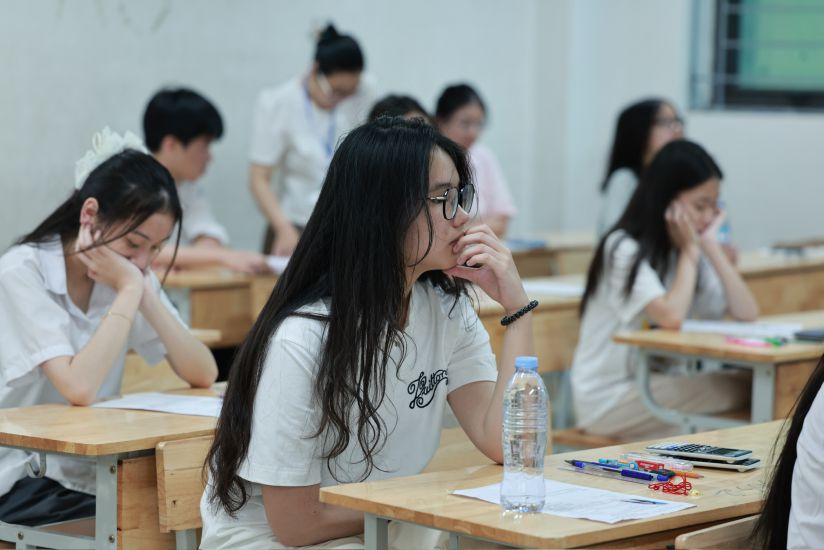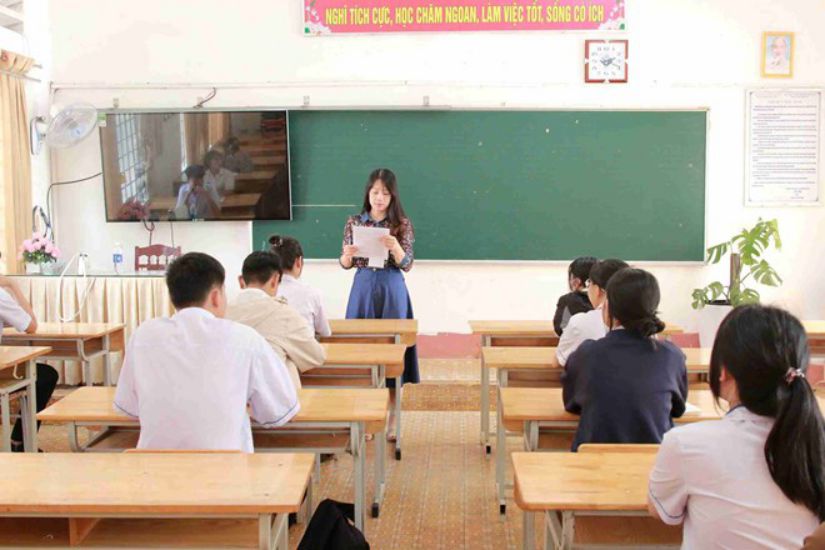Of the 103,456 students registered to take the exam to non-professional public high schools, the enrollment rate to public schools is about 64%, equivalent to nearly 80,000 targets. Although this number has increased by 3% compared to the previous school year, in reality, 1 public school in the heart of the capital has become a "hot race", causing many parents and students to " sit on a pile of fire".
Public school race
Ms. Anh Nguyet is currently a teacher at Nguyen Cong Tru Secondary School, Hanoi. Over the years, Ms. Nguyet has accompanied many generations of students and parents to pass the important exam - admission to grade 10, so this year, she is the parent of a senior student.
As a mother, Ms. Nguyet understands her son's academic ability and does not put too much pressure on him to pass the public school exam. However, her family still encouraged her children to study and study for the exam, trying their best.
Ms. Anh Nguyet's thoughts and views - whether as a teacher or a parent - are in line with modern trends. Secondary school graduates have many options and public high schools are not the only road to success.
However, in reality, not everyone has such an innovative mindset. Every year, Hanoi is always a hot spot for first-year admissions because of the fierce competition for a place in public schools.
Applications at Yen Hoa High School (Cau Giay) and Le Quy Don High School (Ha Dong) for the two consecutive years have the highest rate of 10th grade admission, respectively, at 2.44 and 2.35. That is, 1 in 3 students took the exam.
Meanwhile, this year's entrance exam to grade 10 in Ho Chi Minh City is considered an "easy" exam with the total enrollment target of high schools being more than 70,000 students.
According to Mr. Nguyen Van Hieu - Director of the Department of Education and Training of Ho Chi Minh City, the enrollment quota for this year is allocated by the department based on the materials and teachers of high schools, not based on the traffic flow orientation as in previous years.
Ms. Do Thi Yen Hoa - an admission consultant in Ho Chi Minh City - assessed that the 10th grade entrance exam in recent years has had many positive changes, especially the increase in the number of admissions to public schools, contributing to reducing pressure on students and parents, in line with the Education Development Strategy approved by the Prime Minister.
To continue to maintain and promote efficiency in the coming years, according to Ms. Hoa, the work of affecting post-secondary school students must change, the rate of post-secondary school students entering grade 10 in high school needs to be flexible each year, based on the number of students graduating from secondary school, the material conditions of high school and the characteristics of each enrollment area. Calculating the quota and rate of grade 10 admission appropriately in each admission area is also a way to reduce the pressure of the 10th entrance exam.
In addition, Ms. Hoa emphasized the role of counseling and career orientation for students right from junior high school. "It is necessary to clearly introduce other options besides the public high school system, such as vocational secondary school, high-quality vocational school... However, it is propaganda work to change the concept of entering public 10th grade to be successful" - Ms. Hoa emphasized.

Da Nang needs to be voluntarily
In contrast to the heat of 10th grade admission in Hanoi, Ho Chi Minh City, and other localities, the story of taking the 10th grade entrance exam is quite easy. As in Dak Lak, the education sector also believes that the 10th grade entrance exam can be abolished to reduce the financial burden on people and avoid differentiation in student qualifications between regions.
According to the report of the Ministry of Education and Training, in the 2023 - 2024 school year, about 74.5% of junior high school graduates will attend high school. The remaining, about 25.5% of junior high school graduates study at continuing education centers and vocational training institutions (VETs). This rate is basically stable compared to the 2022 - 2023 school year.
Meanwhile, Project 552 (dated May 14, 2018) on Vocational Education and student orientation in general education for the period 2018 - 2025 of the Government aims to strive for at least 40% of junior high school graduates to continue studying at vocational training institutions at primary and intermediate levels; for localities with particularly difficult socio-economic conditions, at least 30%. Thus, between the set goals and reality, the rate of students after graduating from junior high school participating in vocational training is still insignificant.
Many localities said that the above target is a number that is difficult to achieve for many high schools. Even the use of mechanical numbers in invisible flow activities creates variations and negativity.
For example, in Hanoi, before this year's 10th grade entrance exam, Director of the Department of Education and Training Tran The Cuong admitted that the unit received parents' opinions reflecting on the fact that some teachers or schools, for many reasons, advised students "not to take the 10th grade public entrance exam", or suggested registering for admission to a vocational education center or vocational school.
The head of the capital's education sector affirmed his opinion that choosing any learning model is the wish and right of students and their families. He also pledged that any act of forcedness or misorientation towards students will be strictly handled.
The influx of post-secondary school students is an old story but has always received the attention of public opinion and most recently, at the question-and-answer session, the 9th session of the 15th National Assembly, this content once again heated up the parliament.
Delegate Nguyen Cong Long (specialist of the Law and Justice Committee) recommended that the education sector should review the student allocation policy. He said that this traffic diversion is ineffective and the target of 40% of junior high school graduates will go to vocational training in the education sector, making it very difficult to ensure that students continue to dream of going to high school because they do not have enough classes.
Mr. Long said that for many years, students and parents have always wanted their children to finish high school. Therefore, the education sector should use the high school platform as a basis for traffic flow instead of the current junior high school platform.
"Everyone wants to end the horror of millions of parents and students. Every year, the high school entrance exam is very scary for millions of parents and students" - the delegate stated.
Expressing his views on traffic flow, Minister Nguyen Kim Son also admitted that dividing traffic flow according to a ratio of 40-60%, i.e. 40% after junior high school will go to vocational schools, the rest will go to high school is a way of dividing "very rigidly, lacking scientific and practical basis".
The Minister said that at the end of the 2018-2025 period, the ministry is drafting a proposal for another replacement decree. According to the minister, career guidance must be practical and voluntary to ensure that students who wish to study at high school can all study at high school.
The Minister said that all countries are oriented to popularize high schools and no longer use junior high school as a standard and the unit is currently proposing to amend three laws, including: Law on Education, Law on Vocational Education and Law on Higher Education. Accordingly, the ministry aims for a synchronous and smooth system of interconnecting general education, vocational training and higher education so that the flow from within is voluntary, meeting the requirements of the new period.
Dr. Hoang Ngoc Vinh: It is impossible to apply administrative thinking to traffic flow

Lessons from Germany, Australia, and the Netherlands show that traffic flow is only effective when the education system has a flexible credit mechanism, an integrated program, and substantial connectivity between levels of education and career orientation starting from primary school. There, no one sets administrative targets for traffic flow; instead, there are quality indicators such as the rate of students with personal study plans, the level of satisfaction with career counseling, or the number of vocational skills modules completed before high school graduation.
Decentralization is a correct trend, but cannot be approached by imposed administrative thinking. The policy needs to move towards an open learning ecosystem, suitable for the ability and needs of different groups of people, where each student can shape their own path, with personalized support and maximum respect for choice. Only then can the flow become a "stream" - opening a path for lifelong learning, self-development and adapting to a changing world.
Many schools in Dak Lak have low benchmark scores for grade 10
The Department of Education and Training has just announced the admission scores for 53 public high schools across the province. Accordingly, among the 50 public high schools (excluding 3 specialized schools), many schools have very low admission scores.
The school with the lowest admission score is Hai Ba Trung High School with 2.5 points; Krong Bong High School with 2.75 points; Cao Ba Quat High School and Phan Dang Luu High School with 3.75 points; Krong Ana High School with 4 points...
In the whole province, only 8 public high schools have admission scores above 10. Of which, the highest is Le Quy Don High School with 19.5 points; Chu Van An High School with 15.25 points.

Ms. Le Thi Thanh Xuan - Director of the Department of Education and Training of Dak Lak province - commented: "The education sector organizes the 10th grade entrance exam to evaluate the quality of teaching and learning at the junior high school level. Thereby, the province can evaluate the quality to improve educational efficiency".
Speaking to Lao Dong Newspaper, a principal of a high school (a remote area in Dak Lak province) expressed his opinion: Careful analysis can show that the differentiation between the qualifications of students in urban areas and remote areas with a large number of ethnic minorities is quite large.
The principal of this school proposed to consider admission to grade 10 to reduce pressure on students. He said that although the 10th grade entrance exam in Dak Lak has nearly 22,000 candidates, the scores clearly reflect the quality. Instead of stressing the exam, the education sector should focus on improving the quality of training and facilities. Bao Trung











